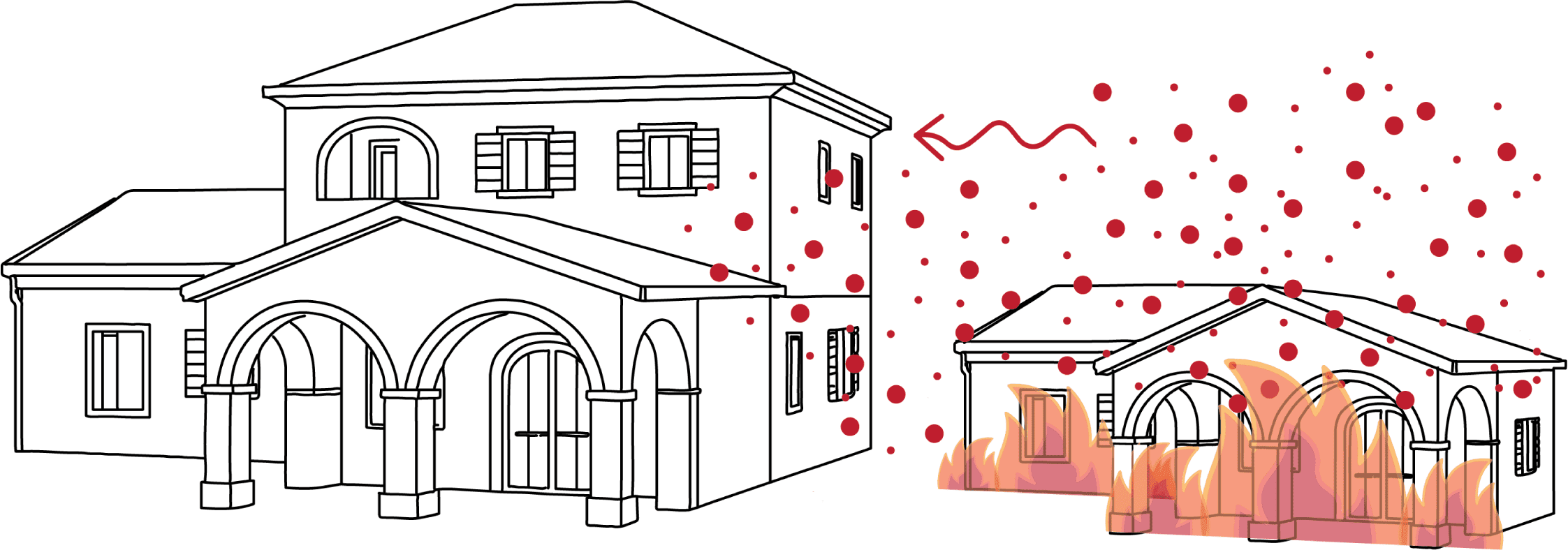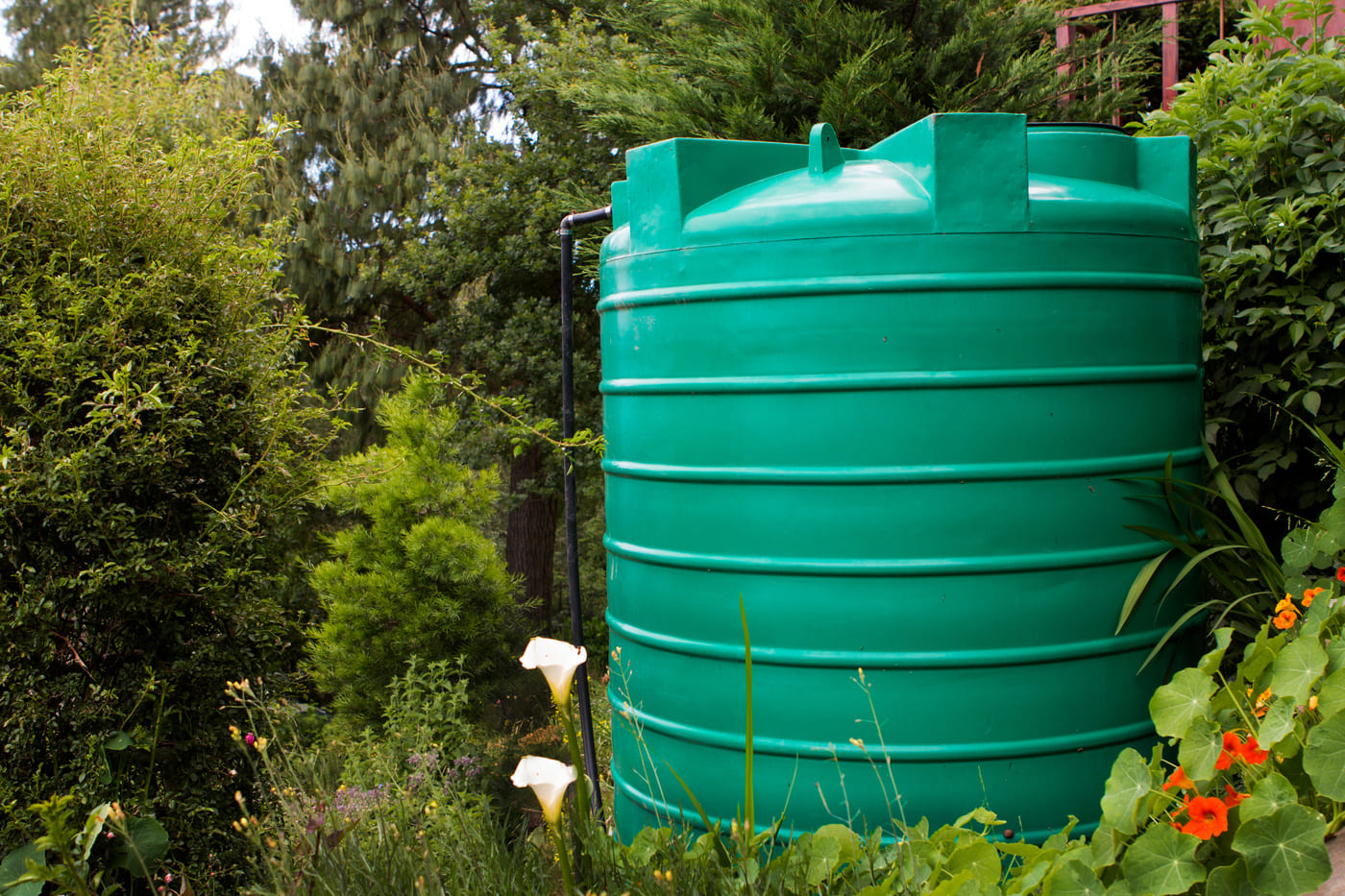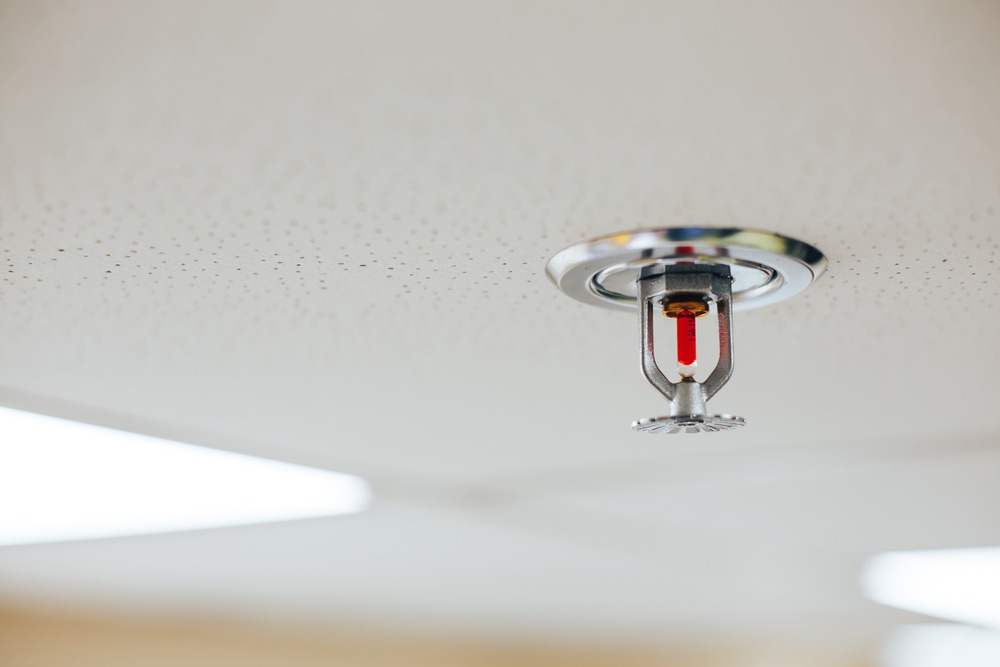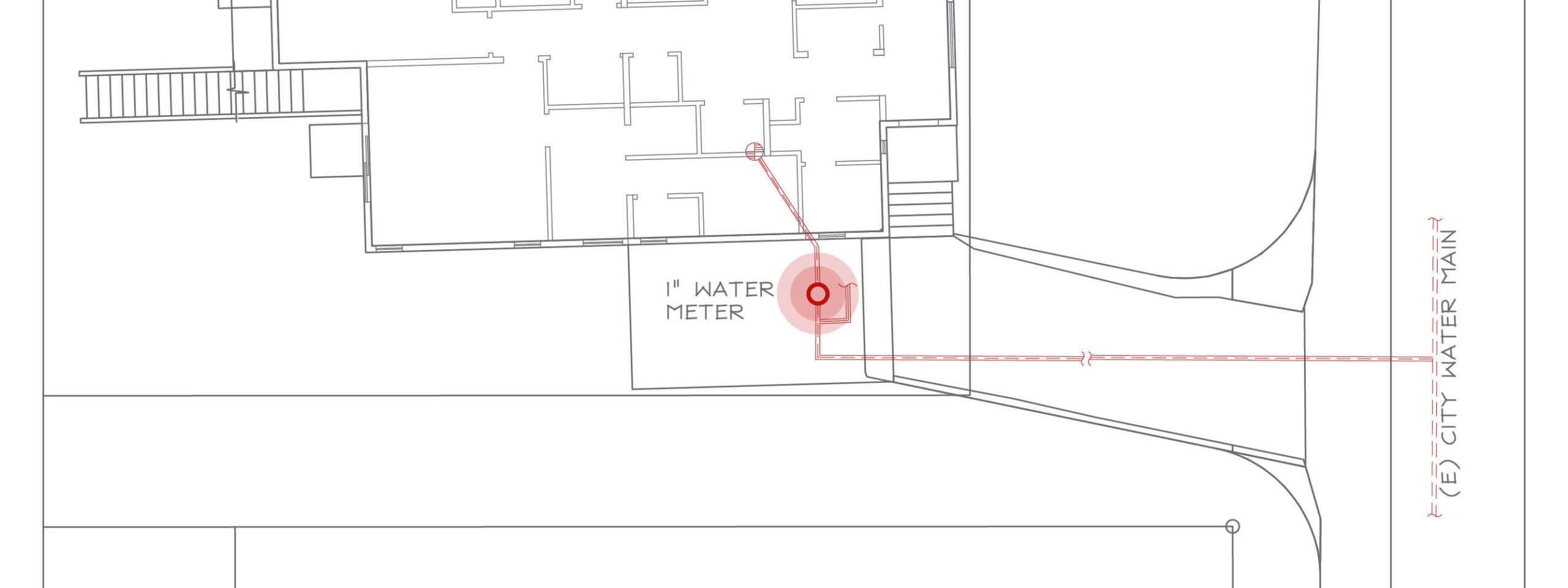Exterior Sprinkler Systems and Wildfire Defense: A Layered Approach
Rising Wildfire Risks Require More Than a Single Solution
Wildfires are no longer rare or seasonal events. In 2024, over one million acres burned in California, continuing a decade-long trend of increasingly destructive fire seasons. Prolonged droughts, stronger winds, and hotter temperatures have made modern wildfires more dangerous and unpredictable than ever.
Research shows that more than 90% of homes lost to wildfires ignite from windborne embers or radiant heat, rather than direct flames. Embers can travel more than a mile ahead of a fire, settling in gutters, vents, and on combustible materials. Meanwhile, radiant heat from nearby burning vegetation or structures can ignite siding and windows from as far as 30 feet away.

Figure 1: Homes can ignite when windborne embers settle on vulnerable surfaces or when radiant heat from nearby burning structures transfers to siding and windows.
This reality underscores the importance of a layered wildfire defense strategy. No single measure can prevent wildfire destruction. However, a combination of defensible space, vegetation management, structural hardening, and exterior sprinkler systems provides the most effective path to reducing ignition risks. Exterior sprinkler systems deliver an active protective layer that significantly improves a home’s wildfire resilience when integrated into a comprehensive plan.
Figure 2: Wildfire intensity highlights the need for exterior sprinkler systems as part of a layered defense.
What Are Exterior Sprinkler Systems?
Exterior sprinkler systems are a permanently installed solution designed to wet ignition-prone surfaces around a property. Unlike temporary measures, these systems are engineered for rapid activation and reliable performance in extreme wildfire conditions.
They serve three critical functions:
- Protecting vulnerable ignition zones such as roofs, eaves, siding, decks, and immediate landscaping.
- Creating a humid microclimate that makes it harder for embers to ignite materials.
- Cooling the surrounding air through evaporation, lowering the risk of radiant heat ignition.
Types of Exterior Sprinkler Systems
Exterior sprinkler systems are customized to each property’s layout, risk profile, and size. Common configurations include:
- Roof Protection Systems: Disperse water across rooftops and eaves where embers are most likely to settle.
- Building Envelope Systems: Shields siding, windows, and decks from radiant heat and direct ember fallout exposure.
- Perimeter Landscape Systems: Hydrate the immediate surroundings, building a high-humidity buffer zone that slows ignition.
Depending on the risk factors of the structure and nearby surroundings, one or multiple of these configurations may be appropriate.
Water Supply and Storage: Designing for Reliability
A reliable water source is the foundation of every exterior sprinkler system. While municipal water can be used, Engineered Fire Systems requires city authorization and approval to ensure the connection meets both regulatory and performance standards.
Limits of Municipal Water for Exterior Sprinkler Systems During Wildfires & The Value of On-Site Water Supply
Municipal water can serve as a supply for exterior sprinkler systems, but it comes with important considerations. During wildfire events, city networks experience extreme demand as firefighting crews draw heavily from hydrants, often leading to sudden pressure drops. In these conditions, a system tied solely to municipal water may face two risks:
- Loss of sprinkler performance if pressure falls below operating requirements
- Competition with firefighting efforts, which can reduce available supply

Figure 3: On-site water supply tanks provide a dedicated, reliable source for exterior sprinkler system operation during wildfire events.
To ensure reliability, it is a best practice to supplement or replace municipal connections with dedicated on-site storage. Water tanks provide a predictable and independent water source, translating capacity directly into runtime. A 2,000-gallon tank typically offers 1 to 2.5 hours of coverage, while a 5,000-gallon tank can extend that to roughly 2.5 to 6 hours, depending on zoning, covered surface areas, and flow rates. Engineered Fire Systems recommends aiming for 8 hours of continuous operation with a minimum runtime of 3 hours.
Power Reliability in Wildfire Conditions
Because power outages are common during wildfire events, sprinkler systems are paired with dedicated generators to ensure uninterrupted operation. These generators are typically 3–5 horsepower (2,200–3,700 watts), sized to meet pump requirements and maintain steady flow.
For ease of use, they include key fob start systems with activation up to 200 feet away. Many homeowners also choose remote app integration, allowing the system to be activated from virtually anywhere. Together, these features ensure that even if the grid fails, water continues to flow when it matters most.
Remote Activation and Evacuation Safety
Wildfire evacuation orders are issued to keep residents safe, yet many homeowners hesitate to leave if they believe their property’s defense systems require manual activation. Exterior sprinkler systems from Engineered Fire Systems eliminate this concern through remote operation.
Systems can be activated from a smartphone app or wireless key fob, allowing homeowners to comply with evacuation orders while still knowing their system is online. Remote access also provides system status checks, giving peace of mind from a safe location.
This approach aligns with fire department priorities: keeping residents out of active fire zones while ensuring properties are defended. By removing the need to remain on-site during an emergency, remote operated systems offer a complete solution.
Addressing Misconceptions
Despite their effectiveness, exterior sprinkler systems are sometimes misunderstood.
- They take too long to set up.” These are permanently installed systems, ready to operate with one-button or remote activation.
- “They connect to my indoor sprinklers.” Exterior and interior sprinkler systems remain separate, each requiring its own water and power source.
- “They disrupt a home’s appearance.” Low-profile brass and copper piping is engineered to blend into roofs and eaves, maintaining residential aesthetics.
Real-World Evidence: The Ham Lake Fire
The Ham Lake Fire in Minnesota offers one of the clearest demonstrations of system effectiveness. The fire burned over 75,000 acres and destroyed 144 structures. Among homes equipped with exterior sprinkler systems, all 188 survived, while more than 100 neighboring homes without systems were lost. Researchers estimated that over $42.5 million in property value was preserved.
This case reinforces what the data consistently shows: while not a guarantee, exterior sprinkler systems dramatically improve survival odds when integrated into a layered wildfire defense strategy.
Frequently Asked Questions
Can these systems be retrofitted? Yes. Most existing homes can be fitted with exterior sprinklers through customized design and installation.
How long does the installation process take? From consultation to final testing, most projects are completed in about four months.
Will this help with insurance? Many insurers now acknowledge wildfire mitigation measures. A professionally engineered system may strengthen your coverage position or reduce premiums.
Will the system work in winter? Yes. Our exterior sprinkler systems are engineered to perform in winter conditions. The on site water supply is stored in a dedicated tank rather than left in the piping, eliminating exposure to freezing temperatures. When inactive, the system can be winterized to safeguard components, ensuring year-round reliability and operational integrity.
Why Engineered Fire Systems?
With over 40 years of fire protection engineering, Engineered Fire Systems brings technical expertise and proven design to every project. Our approach is grounded in data, tailored to each property, and integrated with best practices for wildfire resilience.
Wildfire conditions are only becoming more severe. The time to strengthen your property’s defense is before the next fire season begins, with a system that delivers water, power, and remote control when it matters most.



